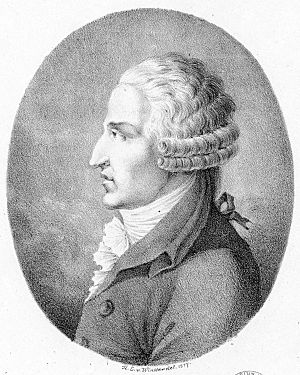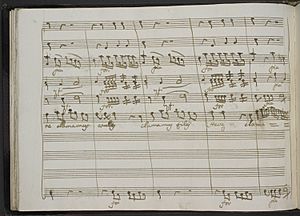Pasquale Anfossi facts for kids
Pasquale Anfossi (born April 5, 1727 – died February 1797) was an Italian opera composer. He was born in Taggia, a town in Liguria, Italy. Pasquale studied music with famous composers like Niccolò Piccinni and Antonio Sacchini. He mostly worked in big cities such as London, Venice, and Rome.
Anfossi wrote more than 80 operas, which are plays set to music. These included both serious operas (opera seria) and funny ones (opera buffa). Towards the end of his life, he focused more on church music, especially oratorios, which are like operas but without costumes or acting, usually telling a religious story. Anfossi passed away in Rome in 1797.
Contents
Pasquale Anfossi's Music Career
Pasquale Anfossi first wanted to be a musician who played instruments. He studied violin at the Loreto Conservatorium in Naples from 1744 to 1752. After his studies, he played the violin in an opera orchestra for ten years. Then, he decided to become a composer, learning from Sacchini and Piccinni.
His first opera, a funny one called La Serva Spiritosa, was performed in Rome in 1763. At first, people weren't sure if he really wrote it all himself, as he often helped his teacher Sacchini with his works. But he became well-known in 1773 with his opera L'incognita perseguitata, which was a type of funny drama.
By 1782, Anfossi had written about 30 operas. Most of these were performed in Venice and Rome, but some were also shown in other parts of Italy and in Vienna. His first opera performed in London was Il trionfo della costanza in 1782. He worked as a music director in London until 1786. During this time, he presented five of his own operas. He also created new versions of works by other composers, like Gluck's Orfeo ed Euridice, adding music by Johann Christian Bach and Händel. However, not all his works were loved by everyone. One critic said his last opera in London, L'inglese in Italia, had "tiring monotony" in its music.
Anfossi later returned to Italy. In 1787, he won back the Roman audience with his short, funny opera Le pazzie de' gelosi. In 1789, he stopped writing operas after 20 years. From then on, Anfossi focused only on church music. He became the Maestro di Capella (music director) at the important church of San Giovanni in Laterano, a position he held until his death in 1797.
Anfossi's Musical Works
We don't know the exact number of all the musical pieces Anfossi wrote. But we know he composed at least 60, and possibly more than 70, operas. He also wrote at least 20 oratorios in both Latin and Italian. His early music sounded a lot like his teachers', Piccinni and Sacchini. It had simple harmonies and sometimes very beautiful melodies.
As he got older, his way of using instruments in the orchestra changed a lot. He started using wind instruments more to create richer and more colorful sounds. In his funny operas, he liked to use the older style of arias (songs for one singer) until the mid-1770s. Later, he moved to more flexible musical parts. He also seemed to prefer longer sections, like the finali (ending parts), and he often included emotional and heartfelt moments in his music.
Some critics felt that Anfossi's music wasn't dramatic enough and that his characters weren't very strong. His funny characters were not as unique as those created by other composers of his time, like Cimarosa and Paisiello. Also, his serious opera music sometimes felt a bit too similar from one piece to another.
For a long time, Anfossi was not remembered as an important opera composer. This was because his works were overshadowed by the very famous music of Salieri, Rossini, and Mozart. However, the famous German writer Johann Wolfgang von Goethe actually put on Anfossi's short opera La maga Circe (Circe, the Sorceress) when he was in charge of a theater in Weimar. Goethe even changed the story a bit and planned a sequel, but it was never made.
Only in the last 20 years or so has Anfossi's music started to be appreciated again. There have been new performances of his works, like Giuseppe riconosciuto. His music was even featured at the 2005 Salzburg Summer Festival, which is a very important music event.
Operas by Pasquale Anfossi
-
- See List of operas by Pasquale Anfossi.
Cantatas by Pasquale Anfossi
- I dioscuri (1771, Naples)
- L'armonia (1790, Venice)
Oratorios by Pasquale Anfossi
- La madre dei Maccabei (1765, Rome)
- Noe sacrificium (1769, Venice or Florence)
- Carmina sacra camenda in nosocomio pauperum derelictorum (1773, Venice)
- Jerusalem eversa (1774, Venice)
- David contra Philisthaeos (1775, Venice)
- Giuseppe riconosciuto (1776, Rome)
- Carmina sacra recinenda a piis virginibus (1776, Venice)
- Samuelis umbra (1777, Venice)
- Virginis assumptae triumphus (1780, Venice)
- La nascita del Redentore (1780, Rome)
- Esther (1781, Venice)
- La Betulia liberata (1781)
- Sedecia (1782, Venice)
- Il sacrificio di Noè uscito dall'arca (1783, Rome)
- Prodigus (1786, Venice)
- Sant'Elena al Calvario (1786, Rome)
- Ninive conversa (1787, Venice)
- Il figliuol prodigo (1792, Rome)
- La morte di San Filippo Neri (1796, Rome)
- Gerico distrutta
- Il convito di Baldassare
- Per la nascita di Nostre Signore Gesù Cristo
See also
 In Spanish: Pasquale Anfossi para niños
In Spanish: Pasquale Anfossi para niños



